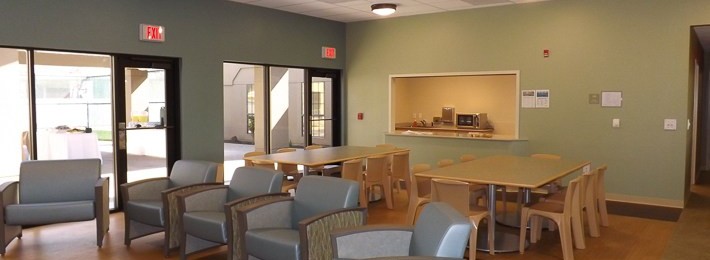Blog
Behavioral Healthcare Design Improvements

With a growing number of adults and adolescents in the U.S. being diagnosed with mental disorders, building and design teams are being called upon to design specialized psychiatric facilities where patients can be treated quickly, safely and with dignity.
Stand-alone Behavior Healthcare Facilities are starting to pop up in communities throughout the country. What is driving this boom in construction?
The Driving Boom in Construction
Contributing to the boom in construction of behavioral healthcare facilities is a paradigm shift in the way mental illness is viewed by society. “The philosophy regarding the treatment of mental illness has completely changed from storage to treatment,” says Mark Hanchar, director of preconstruction services for Gilbane.
No longer are these facilities expected to warehouse patients indefinitely. Instead, patients are being treated with the expectation that they can be rehabilitated and returned to their communities as quickly as possible. Depending on the severity of the illness, the average length of stay in a behavioral healthcare facility is only 9.6 days, according to the National Association of Psychiatric Health Systems (NAPHS).
Mental healthcare professionals are finding it difficult, however, to quickly and effectively treat patients within the confines of ancient facilities designed for dramatically different (and outdated) treatment methods. Most of the nation’s operating psychiatric facilities date from between 1908 to 1928, according to Hanchar. Not only are they antiquated, their physical state is rapidly deteriorating, which helps explain the influx of new projects, both public and private.
Also driving behavioral healthcare facility construction is the sheer number of people suffering from mental disorders. The National Institute of Mental Health reports that about 26.2% of Americans aged 18 and older—about one in four adults—suffers from a diagnosable mental disorder, and 6% of adults suffers from a major mental illness. As a result, acute-care hospitals, where these patients are frequently sent for short-term treatment, are overwhelmed, so the construction of new behavioral facilities helps free up hospital beds.
Design Elements Needed in Specialized Facilities
A lack of acute-care beds is not the only reason psychiatric patients need to be treated in specialized facilities. This patient group has unique problems and behaviors that are better addressed in facilities designed specifically for their needs.
Psychiatric patients are generally physically healthy and capable, but their behavior is wildly unpredictable—acting out and self-harm are major concerns. In general, they react better to surroundings that feel more familiar and personal rather than clinical.
Projects that address those behavioral concerns within the built environment are becoming models for successful 21st-century psychiatric healthcare facilities.
Following are major design considerations for today’s behavioral healthcare facilities:
Aesthetics. Patients need to feel as if they’re in familiar surroundings, so the architectural vocabulary has to feel comfortable and normal. It must also reflect the architecture of the region in which the building is located. As a result, no two facilities should look too much alike or be the same size or style.
Right-sizing. New behavioral healthcare facilities tend to be sprawling, single-story buildings with a campus feel. This design preference is driven by the demand for natural light—a light, airy environment is calming to patients—and the desire to have direct access to the outdoors—visual and physical contact with the outside world is hugely important, according to mental health experts.
Manageability. Managing patients is, of course, a major concern in large mental health facilities, where distances and adjacencies are critical to patient treatment, safety, and security. “When you get above 120 beds, it’s very difficult to do a single-story building,” says Frank Pitts, AIA, FACHA, OAA president of architecture+, Troy, N.Y. “What ends up happening in a large building is that patient units get too big and outgrow support services and are located too far away from those services,” he says. Direct access to the outdoors—one of the main benefits of a single-story building—should never outweigh access to treatment, says Pitts.
Patient rooms. Most behavioral healthcare facilities are moving away from semi-private rooms in favor of private patient rooms with private bathrooms, even though there is no official mandate to do so. “There is a very active conversation about moving toward private bedrooms,” says architecture+’s Pitts, who serves on the AIA Guidelines Revision Committee. Patient safety is one issue, with some experts saying the risk of suicide is less in semi-private rooms because the patient sharing the room can report an incident. Others counter that clinical staff shouldn’t rely on patients to maintain safety. (The most fragile patients—the ones most likely to commit suicide—are generally assigned private rooms anyway, says Pitts.)
Safety and security. Often the biggest safety and security concern in behavioral healthcare facilities is the damage patients can do to themselves. Hardware—hinges, door handles, screws, sprinkler heads, etc.—has to be selected with great care. Removing barriers between the nursing staff and patients is also a safety consideration. Removing the glass, or lowering it so that patients and nurses can see eye-to-eye over an enclosure, often calms the patients, reducing the need for such barriers.
If you would like to learn more about behavior healthcare design, contact Marie Wikoff at Wikoff Design Studio.
Marie Wikoff, CHID, EDAC, LEED, RID  has over 20 years of experience in the field of Interior Design and specializes in healthcare design. Her designs are not only fresh, but also appropriate for the space and the people that they are designed for.
has over 20 years of experience in the field of Interior Design and specializes in healthcare design. Her designs are not only fresh, but also appropriate for the space and the people that they are designed for.
Professional Associations and Accreditations:
- Evidence-Based Design Accreditation and Certification (EDAC)
- American Academy of Healthcare Interior Designers (CHID)
- National Council of Interior Design Qualification (NCIDQ)
- Registered in the State of Nevada (RID)
- The California Council for Interior Design Certification (CID)
- USGBC LEED AP (LEED AP)
- American Institute of Architecture, Allied Professional (AIA Allied Professional)
Source:
JAY W. SCHNEIDER. “Humanizing Behavioral Healthcare Design.” Building Design + Construction, 1 Feb. 2008, www.bdcnetwork.com/humanizing-behavioral-healthcare-design.







